Lost in Japan: A Travelogue (Part 1)
Neon lights shining bright
Exploring bustling city streets
Meeting friendly minds
Knowledge and culture exchanged
Memories to last a lifetime
Introduction
Sometime when I was interning in Summer, an innocent-looking email dropped into my Inbox

It’s premise was comically simple, in a way that reminded me of lottery ads on TV: form bharo aur jeeto Japan jaane ka mauka! (Fill this form and win a trip to Japan!)
Not thinking much, I filled it in. It took all of 10 minutes to do so. IITD being IITD, I knew my chances were slim, because they would inevitably CG sort the candidates and my CG was far from spectacular.
Life carried on as usual. Until I got a call from my dad one day when at work
“Deba, you’re going to Japan?"
“I don’t know, am I?"
“This lady from your university called me because she couldn’t reach your number. Can you email her your details?"
“Oh yeah, sure. Sure thing.”
Night flight to Japan
Once the auspices of a Visa and other preparations were done, our flight was scheduled on the evening of 23rd September, around 7 PM. Before leaving, we met at ex hall to get to know each other, and to book seats on the flight together. With the pleasantries out of the way, our paltan booked out row 55 of the flight, and decided to meet near Jwala Circle at 3 PM tomorrow.
The 23rd finally rolled around, and four of us made our way to the airport from campus. Checking in, emigration and security checks were all smooth, and there was relatively little rush on a Saturday afternoon. After that, we met up with the DU contingent, whom we had also met while receiving our visas at the embassy. While waiting around the departure gate, there seemed to be a surprisingly large number of college students. I thought most of them would be studying in Japan, and some would be our compatriots from the IITs in North India. Didn’t think much of this, and soon it was time to board.
After boarding, the flight attendants started to make their way through the cabin, marking out the seats where an asian vegetarian meal would be served with a green AVML sticker. This included my seat. Seemed very meticulous. Very precise. Very Japanese.
It must be mentioned that at this time, I was working on a paper for ICLR whose deadline was on the 28th. After submitting the abstract, some flaws were popping up in a method that I had proposed, and the hour I spent waiting for the flight was spent fixing some part of this. I thought that I would make more progress, but it’s hard to develop without internet access, and JAL’s internet access has no free tier. Oof.
Dinner took some of this off my mind. It was nothing spectacular: Paneer curry with some rice, fruits, boiled corn, dahi bhalla and a scone. I have no idea why every economy in-flight meal serves this scone. It was there even when I flew KLM. Although that was breakfast, and they also served a slice of cheese with it. There was literally nothing I could pair the scone with. I finally resorted to having it with butter and some paneer curry. Not great, but it’ll pass.
Soon, it was time to doze off. Once I woke up, I ate the second meal they had given me, which was some fruit and a cupcake. We had an hour to land, and they started to distribute immigration forms. Japan requires you to fill these immigration forms. In Japanese fashion, they’re very kawaii and seem like postcards rather than serious government documents. They’re also fastidiously precise, with every field being in a box.
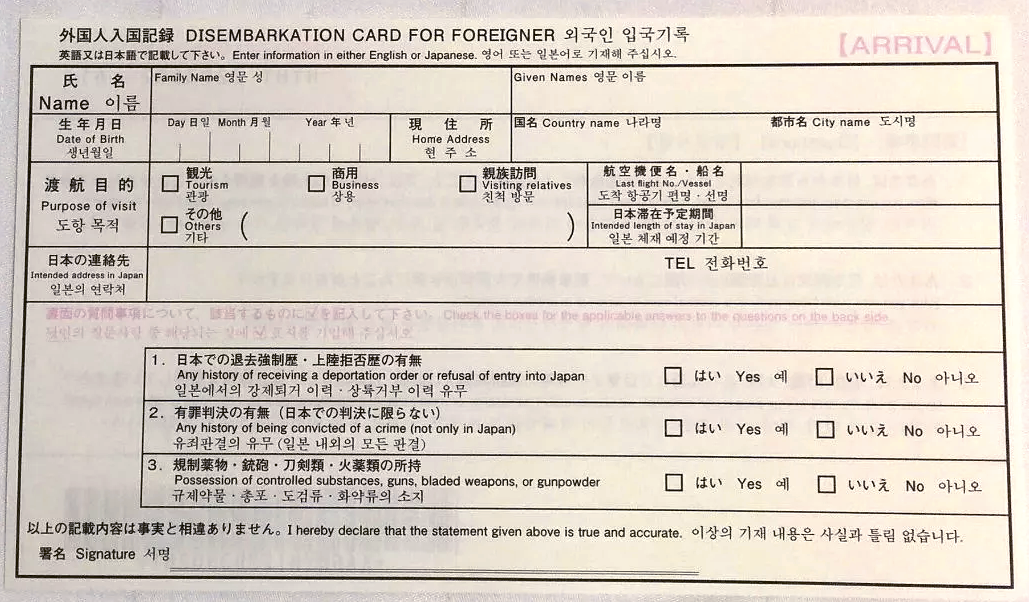
I wonder what will happen to the Japanese Bureaucracy once Maikurosoftu Exceru is deprecated. Maybe budding mangakas would be hired to draw pixel-perfect government forms? One can wonder…
The reassuring thud of land soon came by. One of Tokyo Haneda’s runways is built on land reclaimed from the sea. Unfortunately, we did not land on this runway. Maybe it was for the best, as things built on the ocean have a lower shelf life than their inland counterparts [1, 2]
On disembarking, the rays of the rising sun caressed our faces. Three months after winning the Japan Jaane ka Mauka, it was finally time to say
Ohayo Nihon! (24 Sep)
It was around 6:30 AM Japan time when we landed. Haneda is no different from any large airport, and the walk from the skybridge to the terminal was a long and awe-filled one.
After grabbing our bags, we had to get through immigration. The Japanese love for QR codes beats their love for Microsoft Excel, because there are QR codes everywhere. There’s one for getting through immigration (You can fill their online form and get a QR code), theres’ one on the immigration sticker they put on your passport, and there’s one to get through customs (Again, If you filled their online form). Unfortunately, the customs one requires a digital passport, and we didn’t have one, so it was time to get into another queue.
Once we got through, people from all the invited universities started to trickle in. Apparently, all universities had to board the flight from Delhi to get to Japan, and getting to Delhi was their headache. It was fortunate then, that our visa was hassle-free at the embassy, and all we had to do was take a cab to IGI. Delhi for the win!
We got handed breakfast, and soon piled into a bus, led by our coordinator. Once we were all in the bus, She introduced herself as Kumiko Aizawa, and we were to call her Kumiko-san. That’s interesting, because Rahul told me that the Japanese preferred to be called by their last names. I’m sure that’s true though, so don’t take this experience at face value.
The drive out from Haneda was amazing. We got on these japanese highways, and the signboards were in both English and Japanese. Reminded me of Wangan Midnight. A post-hoc analysis reveals we took the Shuto Expressway into the city, and probably covered part of the Bayshore route. Omoshiroi!
The first stop on our journey was Asakusa, and the Sensoji Temple. Standard homecoming fare: Take the blessings of god before embarking on your journey, and it shall go well. The Japanese are superstitious, but I’m some-stitious. Nevertheless, some of their stitions rubbed off on me. I hope the lucky incense helped (I’ll need the luck for PhD admissions :P)
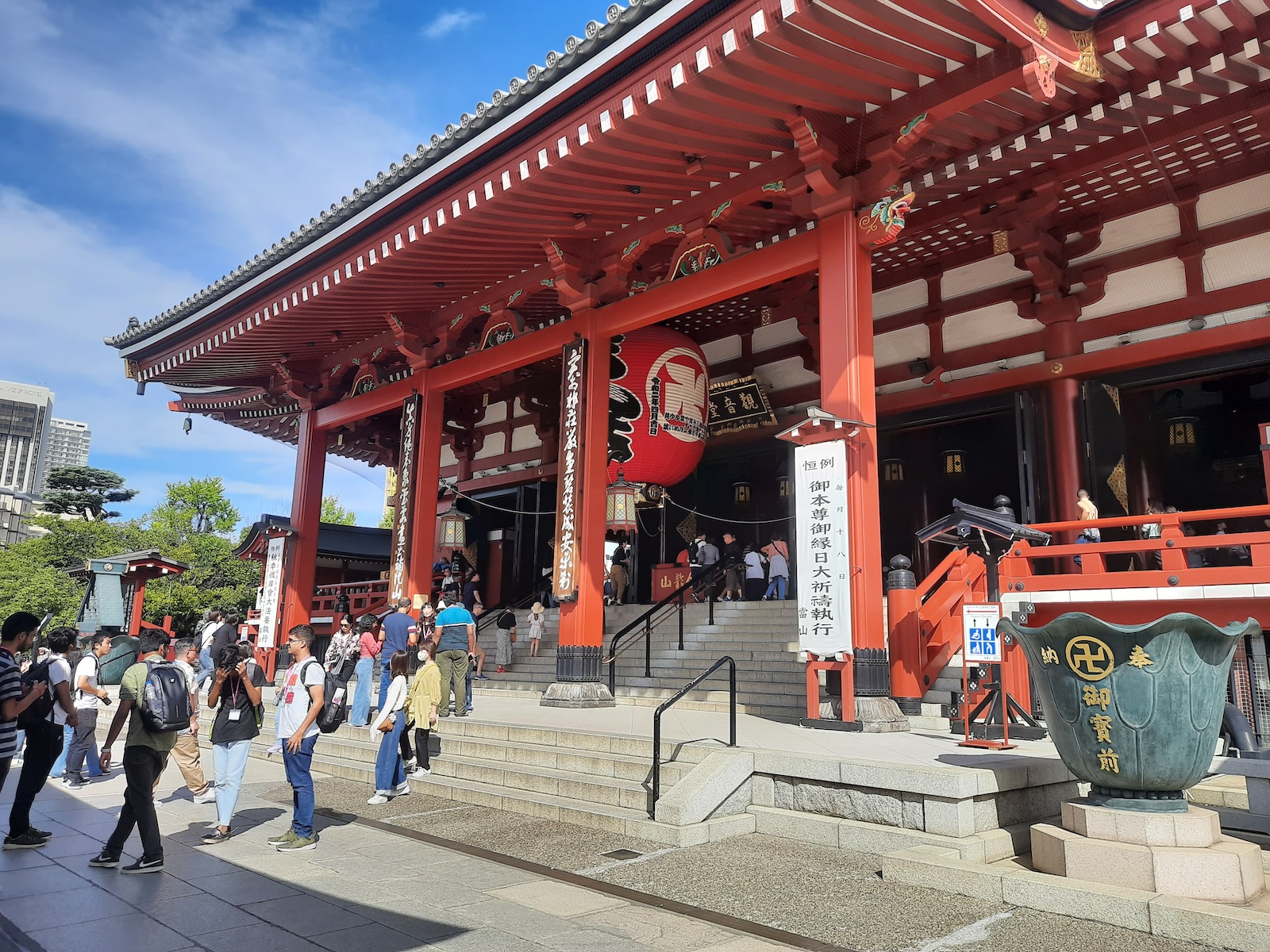
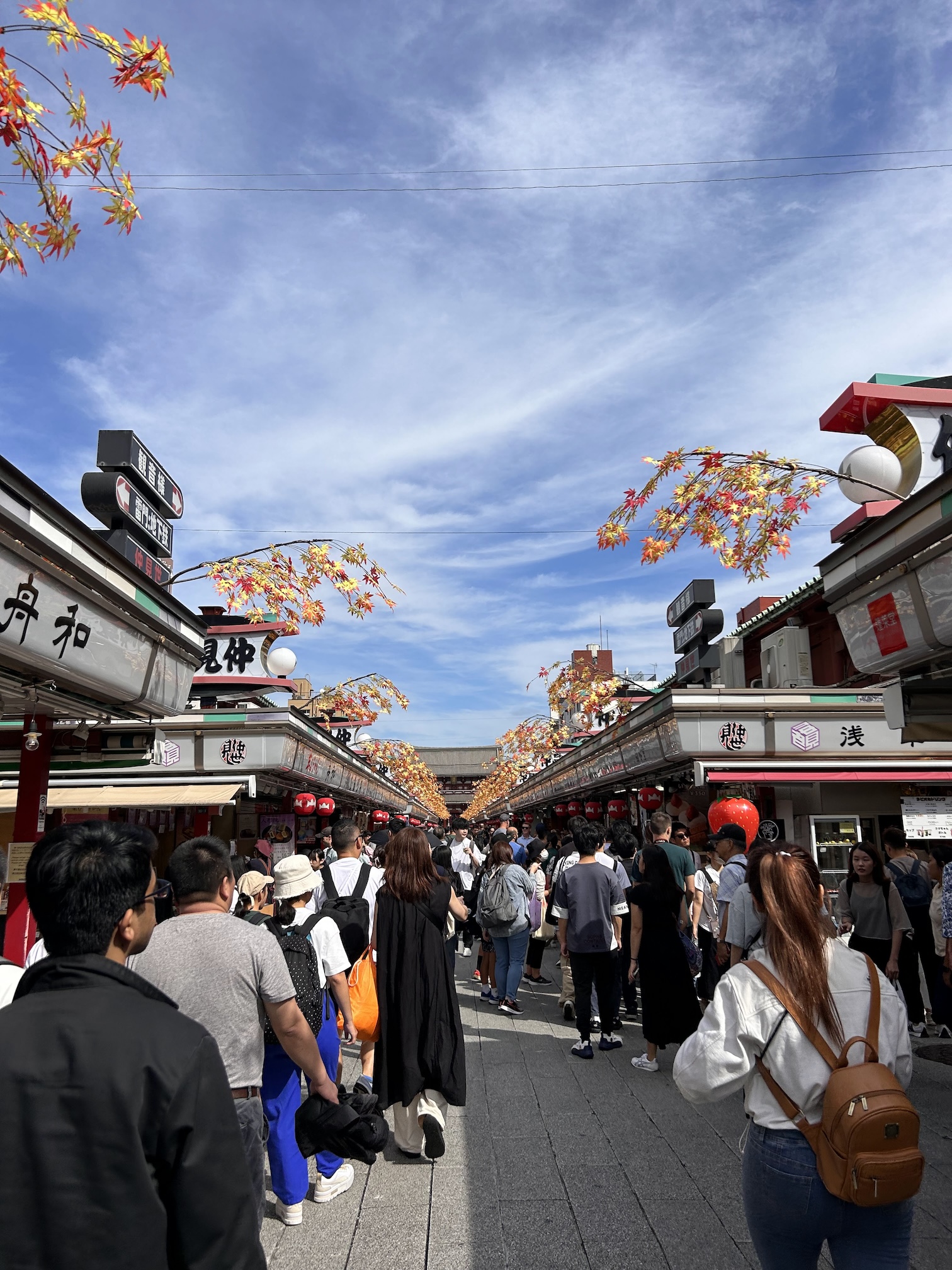
Soon after, we hopped down to Tokyo Skytree. This is the latest and tallest observation deck in Tokyo, and is the tallest freestanding structure there ( 640 metres, iirc). I’ve been to Euromast previously, and that was hardly half the height of this monstrosity. You’d sprain your neck looking up at the top.
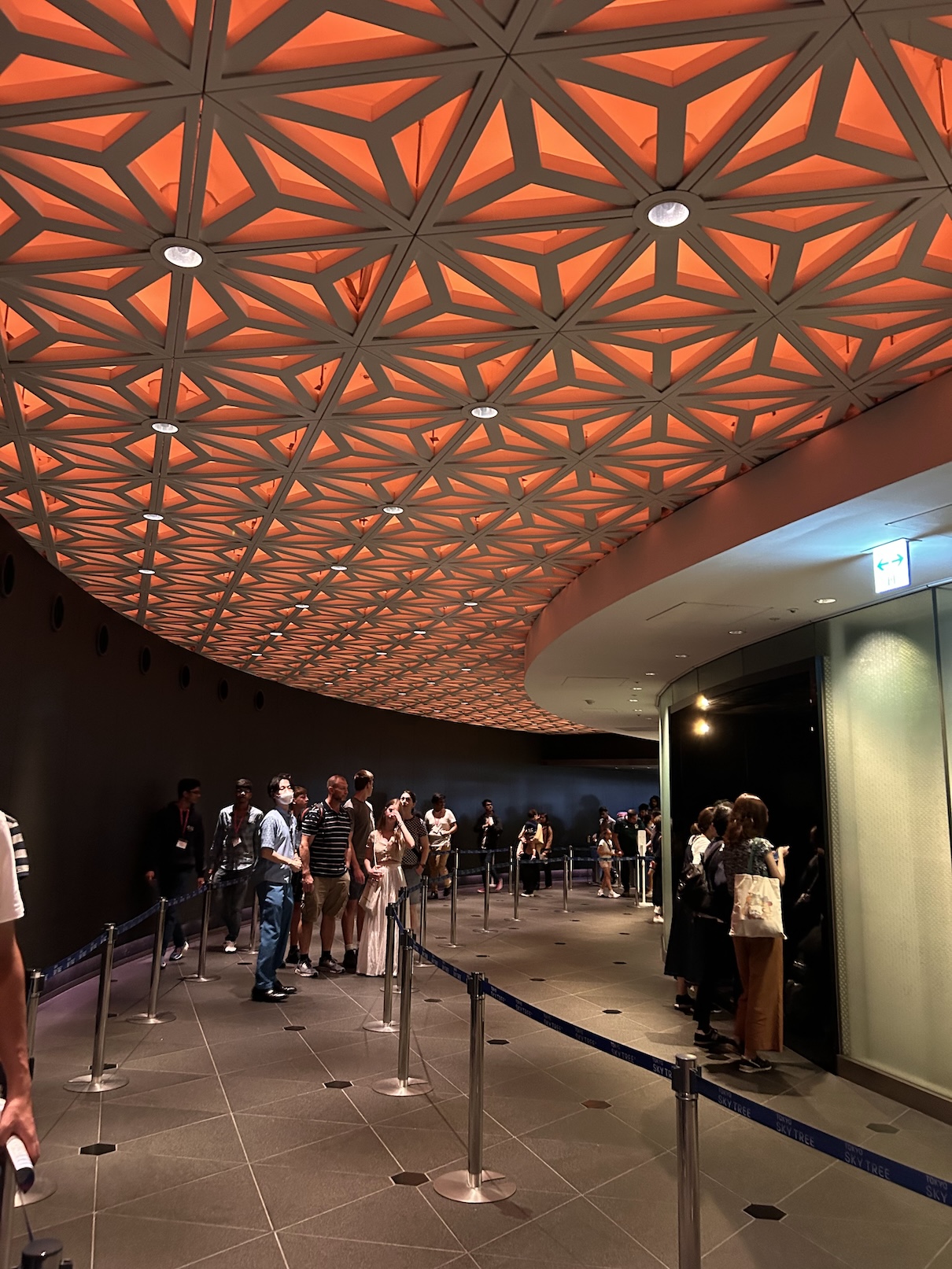
Fortunately you don’t need to look up for a long time, as the superfast lifts will take you up in less than a minute! Each lift has a theme, and we took the spring one while going up and the winter one while coming down. The acceleration is quite gradual, so the only indication you’re moving very fast is the pressure change, and you can feel your ears pop as you get higher.


Once upstairs, you could see all of Tokyo. There wasn’t much to see, other than a metric ton of buildings. A concrete forest, laced with the occasional shining stream of water. You could make out Mt. Fuji in the distance, rising amidst the fog.
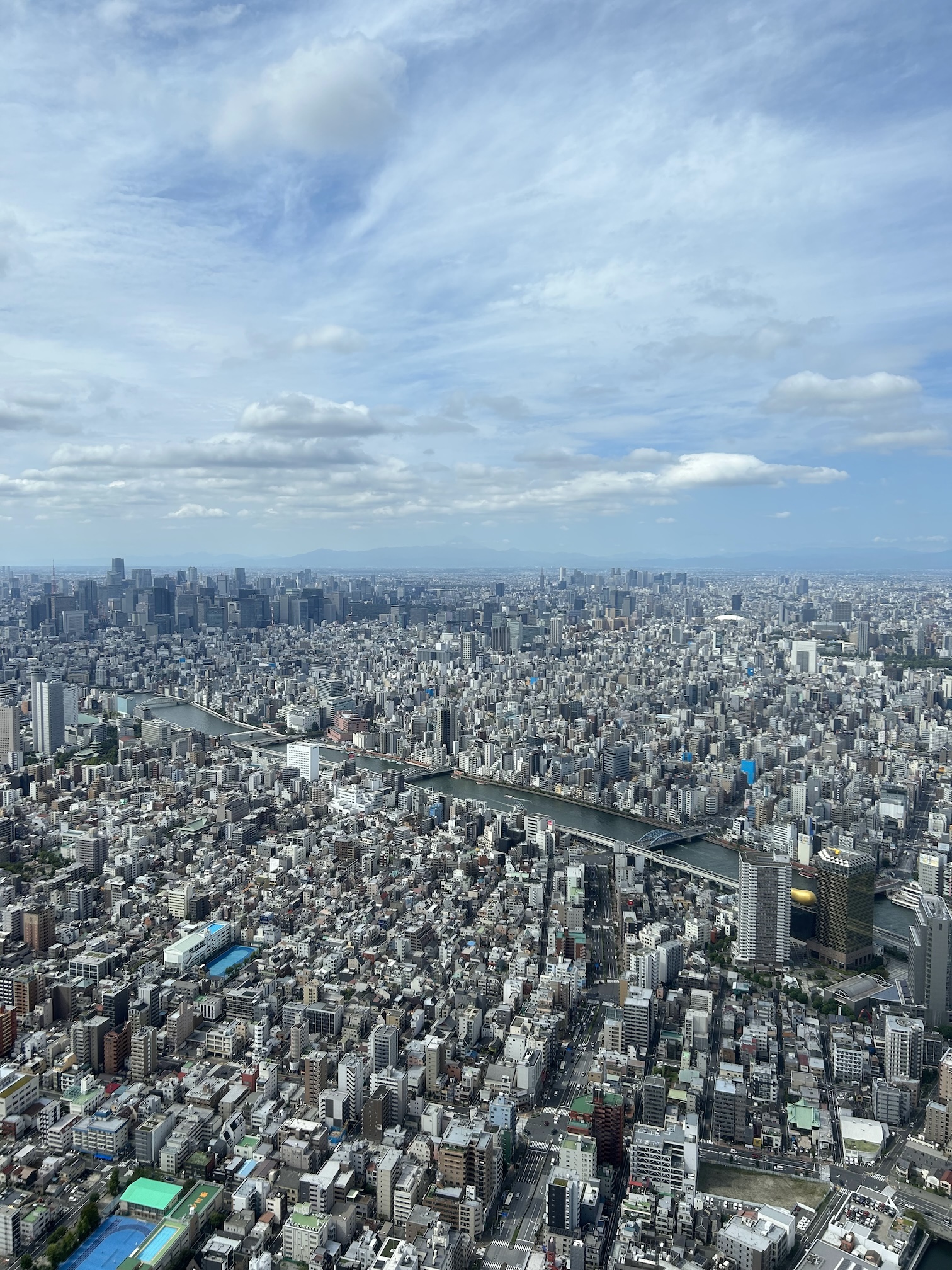
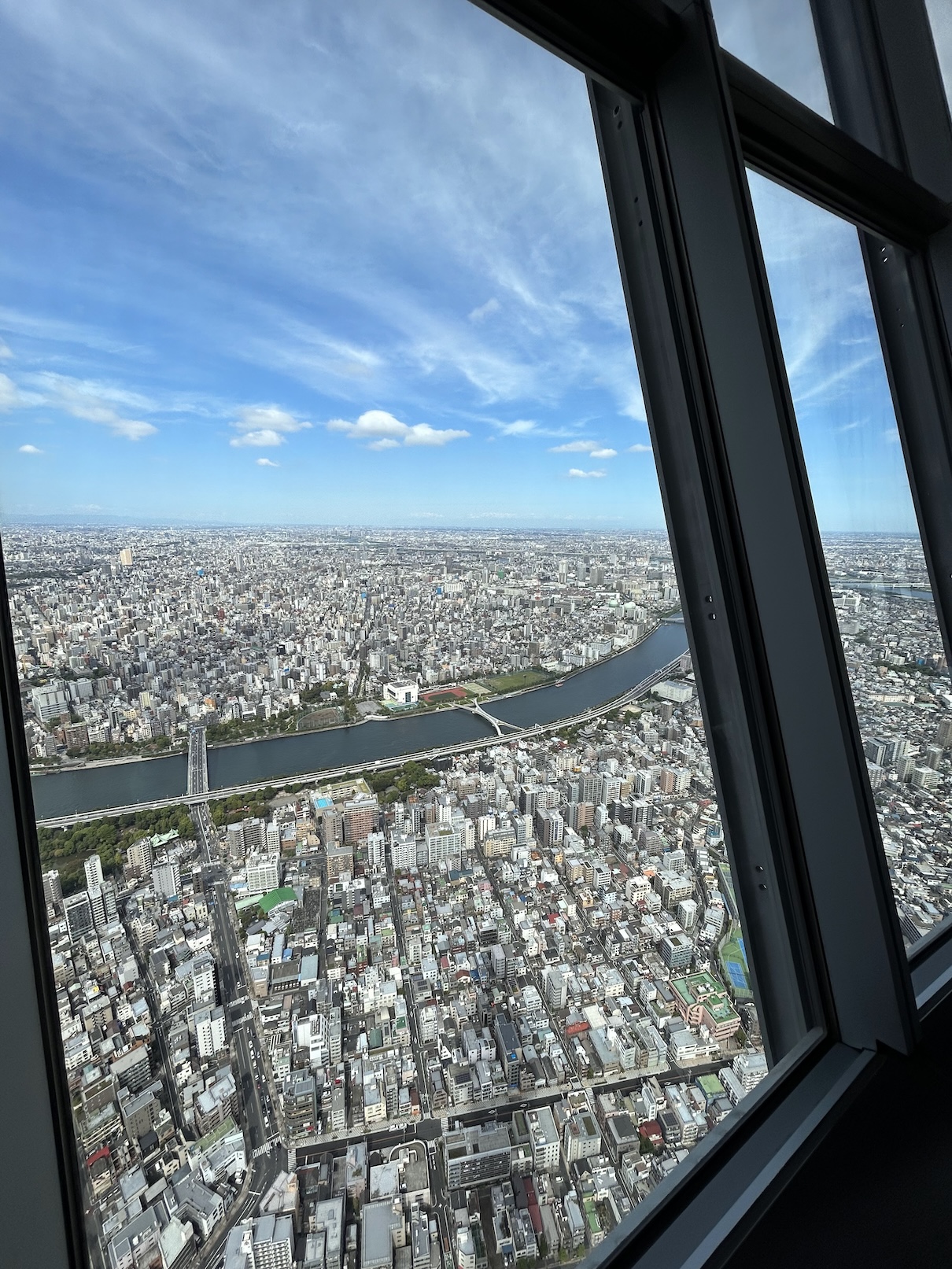
After taking a quick round, we had more time to kill, so we ran down to the transparent floor area and took some pictures. We returned back to the meeting point, only to be taken back to the transparent floor again :) very nice.
After this was time for lunch. We went to an Indian restaurant, which almost all of us had booked out (or I thought so, as I didn’t see any others there). The vegetarians and non-vegetarians were separated, and I had palak chicken with Dal, Naan and Sticky Rice. While the food was decent, there’s more about it later.
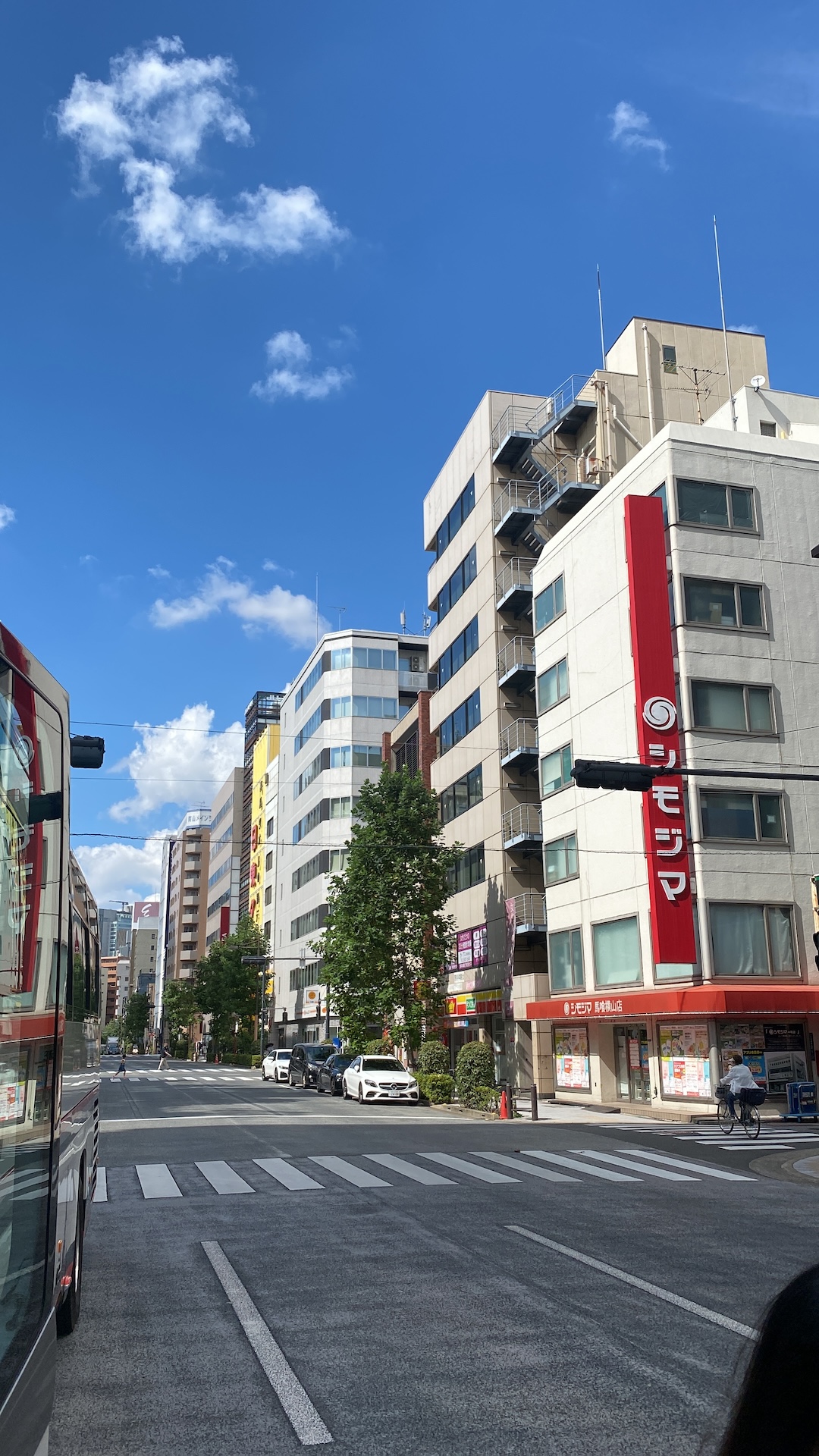
The next stop was the JST office, located at the Science Plaza. The area seemed expensive: A Bentley Bentayga and Rolls Royce were casually parked around. I don’t think government officials are paid very much more, so the surrounding neighbourhood probably became more expensive, and the building stayed where it was. Once in, we were shuttled off to the basement. With thirty minutes left before we started (The japanese are super-punctual).
After the meeting, the last stop was our hotel. We were living at the Metropolitan Edmont, in Iidabashi. We were allotted three a room, but with only one card to start out with. It was okay in a pinch, as we had to stick around for a week at most. Housing in Tokyo is also quite expensive, so JST probably had a limit on how much they could spend on housing. Which is fair. The rooms, however, were great. Decently large and quite inviting, with a view out over the highway. The Japanese equivalent of Atithi Devo Bhava is Omotenashi, meaning to wholeheartedly look after guests. I think they had this down to a T so far.
After settling in, I took a quick shower, had some green tea and chatted with my roommates. We then dropped down for dinner at another Indian place close by. Surprisingly, the dinner was almost exactly the same: Naan, rice, dal, chicken and a Onion Bhajji. While Omotenashi is great, it dawned on us that we would be eating Indian food every lunch and dinner. And I was already tired of eating Naan.

Shibuya (24th night)
Chatting around the dinner table, we quickly hashed out a plan of visiting Shibuya, jetlag be damned. We decided to convene downstairs at 7:30 PM, and take the metro to Shibuya.
In addition to the elaborate lists of things people had to get from Japan for themselves, because they had seen it on YouTube, or in an anime or manga, they had also taken up the duty of becoming delivery boys (and girls) for their friends and family. An International BlinkIt/Instamart, if you may. Our paltan was no different. Heck, I was no different. However, I had an ace up my sleeve that the other travellers didn’t: Clarity. I had set foot on this island with one and only one shopping goal - To get a good mahjong set.
I’d love to take a twenty minute detour to explain what Mahjong is, but I digress. We reached Shibuya in around 15-20 minutes, and the first thing we see on crawling out of the subway was the famed Shibuya Scramble.
It seemed like any other chowk in Delhi, just more organized. Cars puttering around. People standing.
Until the lights turned red.
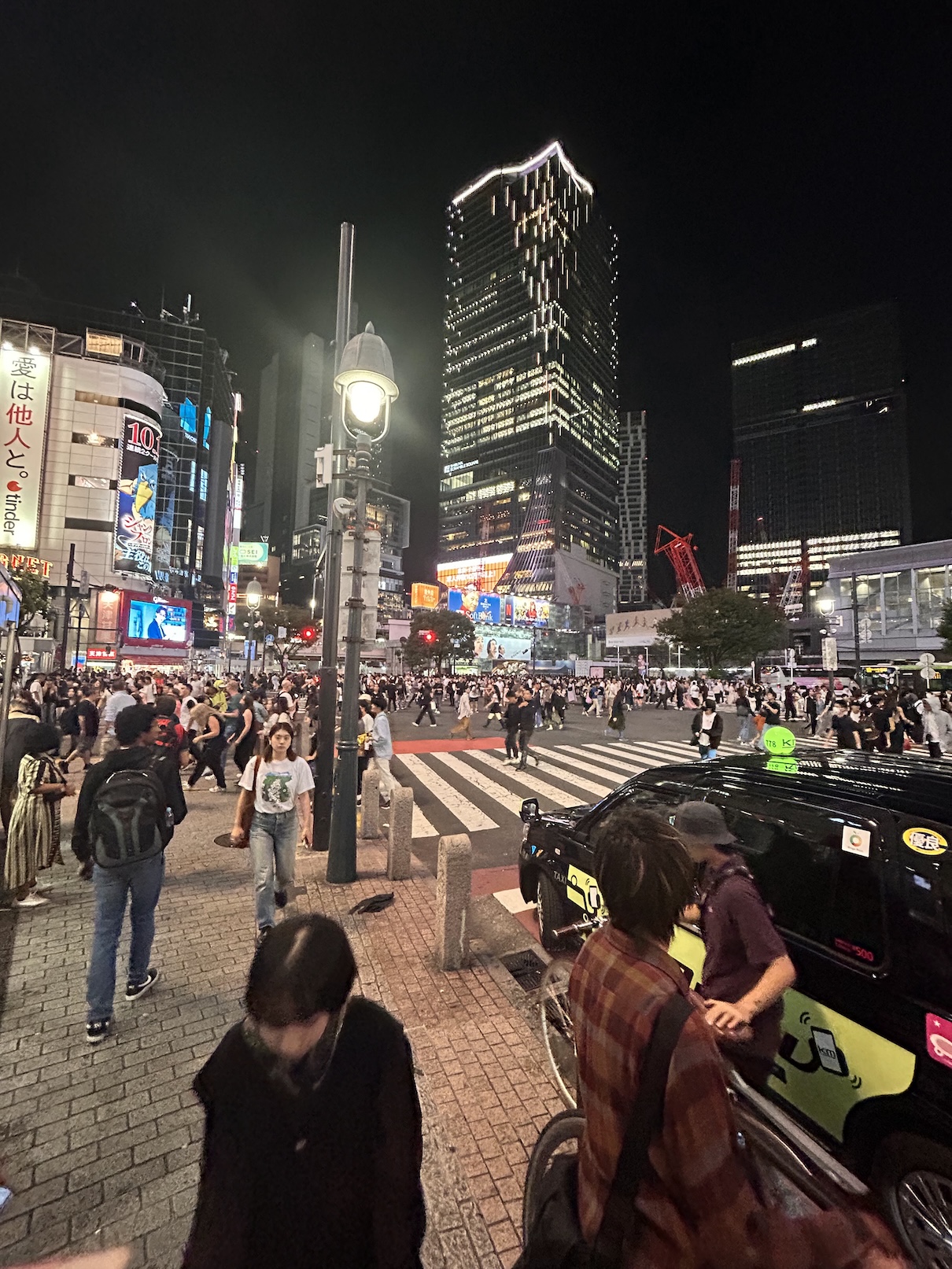
You can’t really see the crowd on the other end because the cars block them, but once the pedestrian lights turn green, it’s a tidal wave of people. It’s like someone filled a glass halfway with people, and gave it a swirl. And the most surprising thing is that amidst all this chaos, everything goes back to normal once the lights turn green. The scramble stops scrambling, and becomes another ordinary chowk.
After dashing around it like only tourists could, we decided on where to go next. Rajeev wanted to go to Onitsuka Tiger to get some shoes for his friends, and all of us followed. However, the store turned out to be an Onitsuka store, instead of an Onitsuka Tiger.
What’s the difference?

Onitsuka is apparently a more formal spinoff substore of Onitsuka Tiger, which itself is a semi-formal spinoff of what is now ASICS. We had made the rookie mistake of confusing JavaScript with Java, and turned back dejectedly.
Since nobody had any plans in particular, it was time for Mahjong. I looked on Google for toy stores around me, and found this place called Mega Don Quijote, which was a bargain store with a very high rating. Good choice of name. It was also just a five-minute walk, so we set off for it.
On reaching, we found that the store spanned seven floors, with toys somewhere on the fifth floor. Welp, atleast they had escalators. They also had cosmetics, which Shriya wanted to have a look at. After a totally democratic vote1, we decided to scour the shop from top to bottom.
On reaching the top, there was nothing of particular interest. Going one floor lower, there was still nothing of interest. The third floor, however, was supposed to have toys. On getting there, all of us scoured the area for anything resembling Mahjong. There was Pokemon, watches, and an adult section cordoned off with curtains.
And then there were Board Games. And then there was Mahjong.
The first set I picked was as long as a guitar. No way I was carrying that back in my bag. The next set was smaller, and blue. It also had a decent heft to it. “AMOS SMART”, read the cover. This is a game for smart people.
“There’s one more over here” Atul said. This one was red, about the same size, and weighed much more.
“AMOS MASTERS”, read the cover. I’m definetly not a master. I hardly even know this game.
I then flipped both over to peep at the pricetags. The Smart set was probably 6000 yen, while the Masters one was around 8000 yen. That’s around 4.3k for those at home.
Buying the cheaper set would have been the Smart decision. Guess which set I took back.

And so, Mission Mahjong was accomplished. The next stop was the cosmetics section, but I’ll leave the gory details out of that one. It was the equivalent of leaving four dogs and a cat loose in a china store. However, we proved to be of some help, and found atleast a couple things.
On the way down, we bumped into the KGP group, who had stuffed their bags with KitKats. KitKat was a bit cliche, and most of the kitkats we looked at were overpriced. Our group took a lot of Pocky back instead.
After checking out and taking the metro back, I hit the bed and grabbed whatever little sleep I could. This was going to be a rollercoaster of a week!
Imperial Palace, Keio University (Mita Campus) (25 Sep)
We were supposed to start at 8:45 AM the next day. Breakfast was in the hotel, and we (or I) was still stuck following Indian Standard Time, which means being 15 minutes late to every event. It didn’t help that my roomies were similar too.
After throwing on a shirt, jeans and my bag, I hopped down to grab breakfast. I had only 15 minutes left on my clock, and just threw together whatever I could find, skipping the fruits/salad section entirely. There was a lot of meat on the table. Being a vegetarian seems to be an Indian thing.
After gobbling down breakfast, we hopped down to the meeting point just outside the hotel entrance. There, Kumiko-san took our temperatures and noted them down on a paper. Which had a table to note every person’s temperature, for 7 days. On a clipboard.
These people were meticulous! I love it!
The same can’t be said of us. Half of us were late by atleast 15-20 minutes on the first day. Once all members of a contingent assembled, they were asked to go to the bus in which they had originally sat yesterday. We had Bus No. 2.
Once in, everyone got what amounted to a mini scolding.
Japanese are very panc-tu-aru. Prease try to be on time.
This would’ve been the best school trip, if I was still in school. Might even have come to Japan to do my undergraduate. Things felt cozy so far!
We then got introduced to Keiko-san, who was the second guide on our bus. She also sang a song, and then started teaching us about the emperor of Japan and the Royal Family. Like every monarchy, even they have their problems. Their princess married a commoner (similar to Prince Harry) and had to give up the royal title. The heir to their throne is 10 years old. Also, like every other monarchy, it’s constitutional, so very little actual power rests in their hands.
We soon reached the imperial palace, and saw the statue of Kusunoki Masashige.
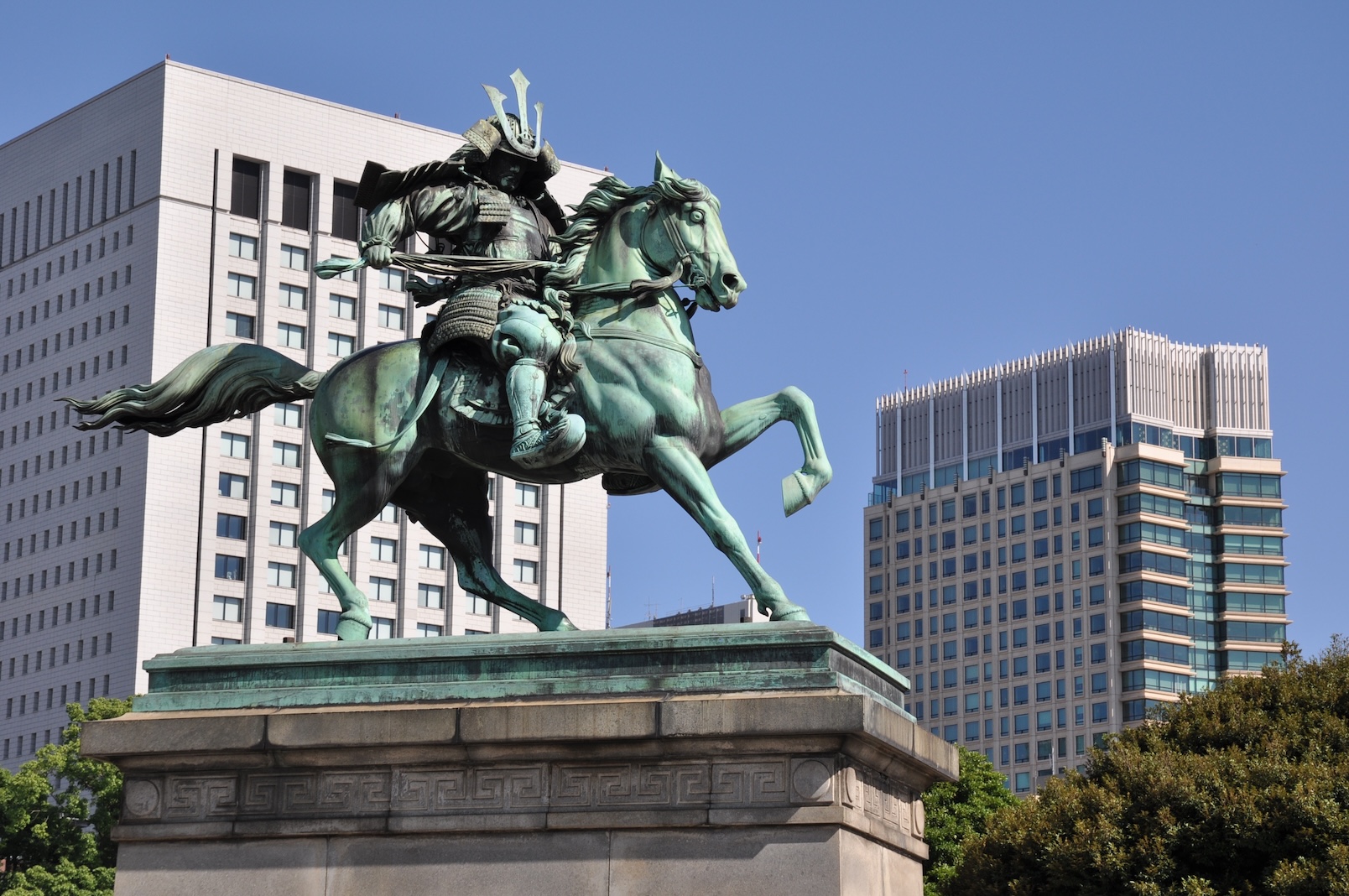
Masashige was a samurai, remembered for his loyalty to the emperor. After this, we went to the front of the imperial palace, and took contingent pictures in front of the nijubashi bridge.
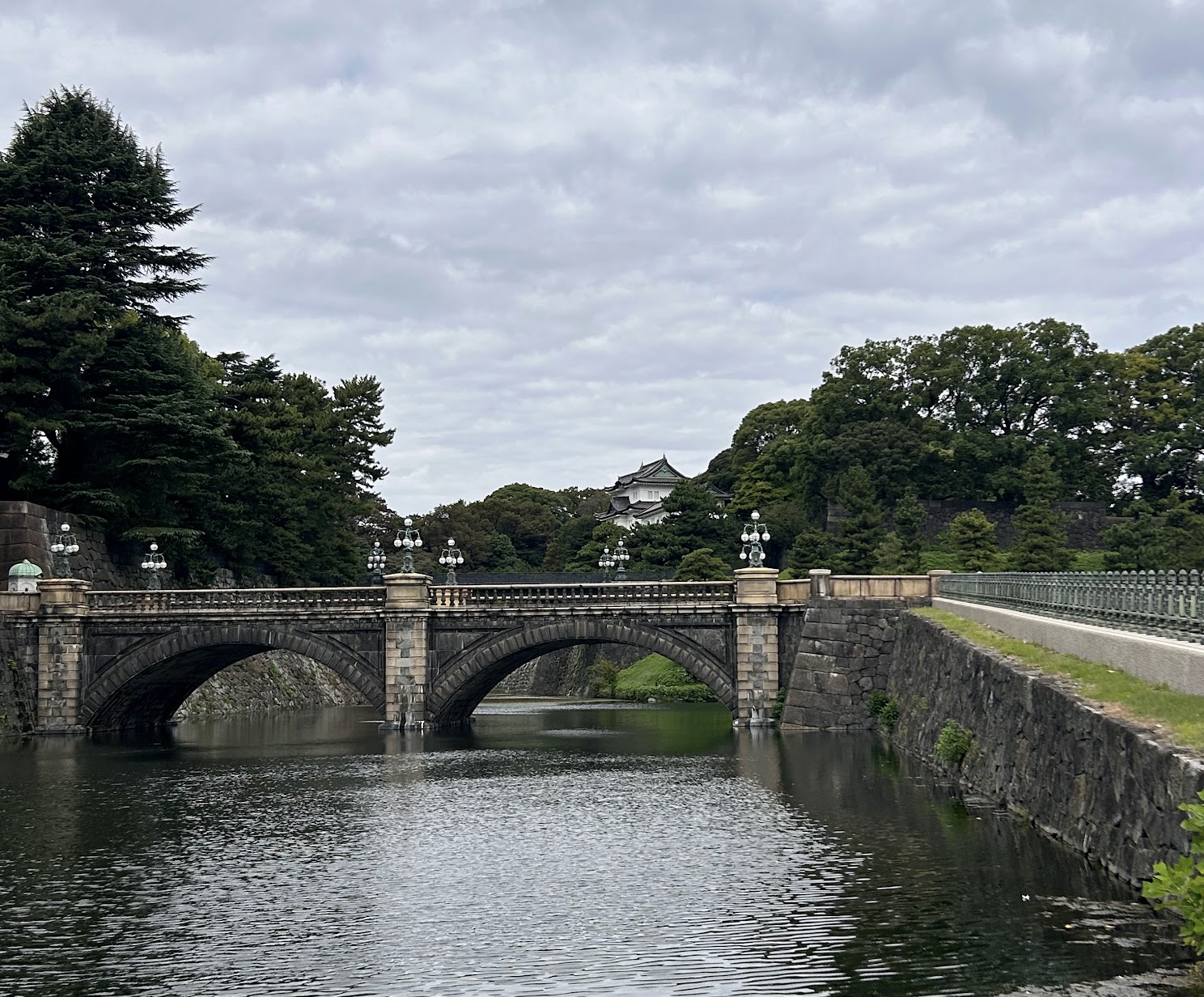
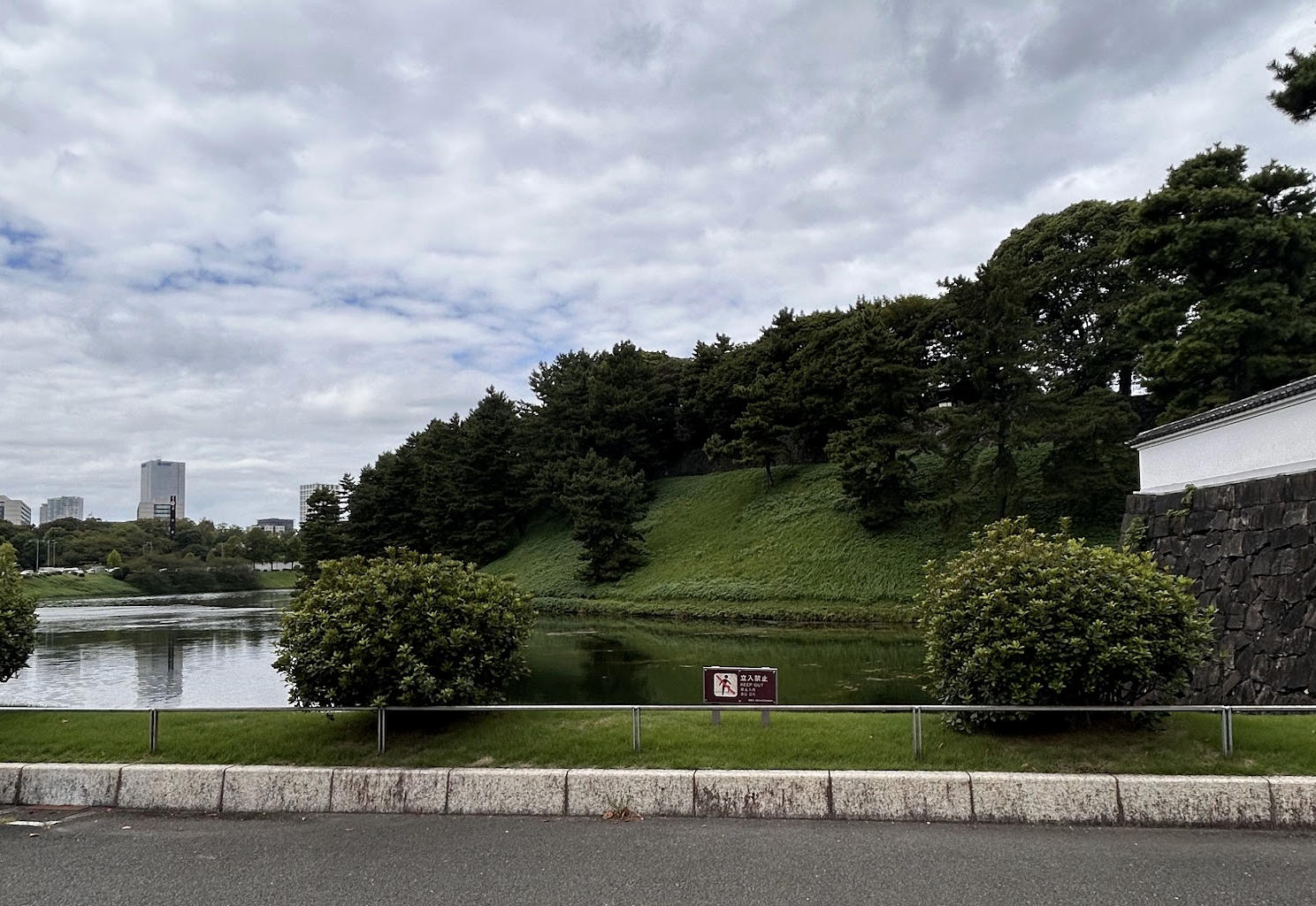

The doors to the palace open only twice a year, and today was not one of those days. After walking around, we went to the souvenir shop, where everything was super expensive. Since nobody wanted to buy anything, we went back to the bus and chatted a bit. After that, everyone caught up on some sleep on the journey to Keio.
We stopped at another Indian restaurant close to Keio for lunch. In the spirit of Omotenashi, it was all but confirmed that we would have Indian every single day of the week. The Indian food in Japan is okay. The naan is a bit westernised, and more bread-like than naan usually is. It’s also not buttered, and is a bit too big (see above for the size).
Anyway, with lunch done, the buses took us a short distance to Keio University’s Mita Campus. The campus was about as large as St. Stephens, and gave old-money vibes. It had a very modern entrance, with a flight of steps to walk through to enter. The campus was also quite empty! I expected a bit more bustle. This was a common theme across most campuses we visited. Where are the students? Or is it holiday season in late september in Japan?
Once in Keio, we were shuffled into their conference room. Keio had a bottle of water emblazoned with their own logo. The advantages of old money. I wonder what would happen if we started handing out bottles of water which said ‘IIT Delhi’ to all our visitors. Taxpayer advocates would have a field day.
Soon, a lady walked up and said ‘Namaste’. She then started speaking impeccable hindi. Which was surprising, considering she was Japanese. She then introduced herself as Tomo Kawane. She had wanted to study about Gandhi, and so came to India and did her masters in JNU, so she was familiar with what zindabad and murdabad meant. Kawane-san then spent a long time in India before coming back to Japan.
Wow.
Talk about making a statement. I was hooked at this point. Fortunately, the other speakers were good too: We had Prof. Rajib Paul speak about the India-Japan Laboratory, and some Indian and Japanese postdocs there spoke about their experiences. This was followed by a host of three speakers from Keio, Rakuten and Yokogawa Electric.
Once that was done, we dropped down to the auditorium for a group photograph. Walking out of Keio around sunset, the campus looked grand. Wouldn’t be a bad place to study. Unfortunately, the Mita campus is only for their humanities students. Engineering is located on the Yagami campus, which we were to visit tomorrow.
After this, a nice dinner was planned for us in Ginza. The bus first took us down to a toy shop (Yes, this would have been much better if I was in school). Dinner was on the sixth floor of the building, and we had half an hour to stroll around. This is another interesting tokyo quirk: Large stores are spread out vertically and not horizontally. Multiple stores occupying consecutive floors of a high-rise are not uncommon here. Seems like a smart decision, considering how densely built up Tokyo is.
I got a compass for my sister with a retracting tip. I also saw the exact same mahjong set a few floors up, retailing for 11,000 Yen. So I hadn’t made a bad purchase per se :) I also fancied a deck of Hanafuda cards. A friend had taught me to play Koikoi, and we used to play with his deck. Would have walked out with a deck but they were unfortunately a bit too pricey.
Dinner was good. Chicken biryani. A welcome change from naan. Dinner also gave me a good view of the highway outside, and I could see the cars whizzing by, filled with salarymen returning home from their jobs. Things were very orderly here.
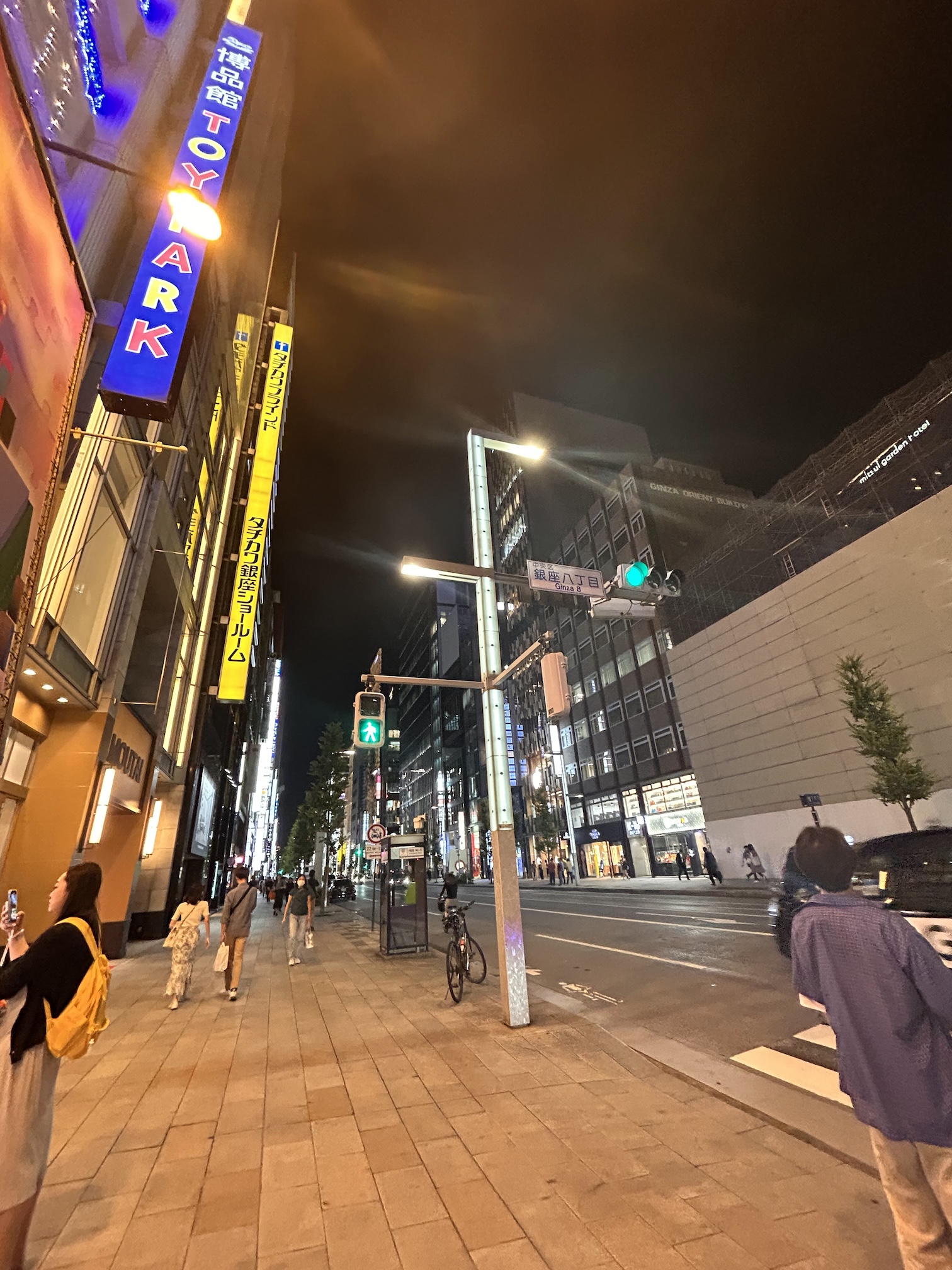
Once done, we had a few minutes to stroll through Ginza. Ginza is the upmarket shopping district of Tokyo. The closest equivalent is Select CityWalk in Delhi, but that still feels like a tacky gimmick compared to Ginza. Watches costing tens of thousands of dollars are casually placed in storefronts for people to wishfully window-shop. Narrow sushi shops which are probably michelin-starred dot the place. If this were India, you’d probably have barred gates and multiple security guards in front of each store. Ginza is luxury done right, a phenomenon only possible in a lawful and peaceful State.
Since none of us have such expensive tastes (yet!), We walked into an apple store across the street and took some pictures. Played around with the new iPhone (The power button doesn’t move!). After window-shopping a bit more, time was up and we hopped on the bus to take us back to the hotel. On the way back, we spied the Wako store while going through the famous Ginza 4-chome crossing.
Shinjuku (25th night)
Daiso is a cute store where everything retails for a 100 yen2. It’s the japanese equivalent of a dollar store. After getting some snacks, we hopped into the metro.
Tokyo’s metro is the best metro system I’ve travelled in, bar none. There are gates everywhere, stations are huge, train cars are huge, trains are on time and super frequent, it’s very clean and well-maintained and there are signboards in English! It’s also not prohibitively expensive like Amsterdam, but also not as cheap as Delhi.
Unfortunately, for newbie metro users, the experience can be a bit jarring. There are two metro operators in Tokyo: One is Tokyo Metro, which controls most of the lines, and then there’s Toei subway, which controls a few. Tickets bought for the Tokyo metro lines don’t work on the Toei Subway lines. Which is what surprised us when we bought a ticket and it wasn’t punching through. Not knowing these two lines are different, we went up to a official sitting near the gates.
“Sir, these tickets doesn’t work”
squints “Ooo, you take ticket from there” points to right
“Okay. What do we do with these tickets?"
scrounges in the back
coming back with a refund in hand “Give ticket”
Wow. That was smooth. And very helpful. After profusely thanking him, we took tickets and got on the metro. Next stop: The Tokyo Metropolitan building.
The Metropolitan building is basically a government office for the Tokyo Metropolitan authority. In a country where people pay their taxes, the government has a very nice office building. So nice, in fact, that the top floors double up as an observation deck! And entry is free, and they have a hyperfast lift to take you up!
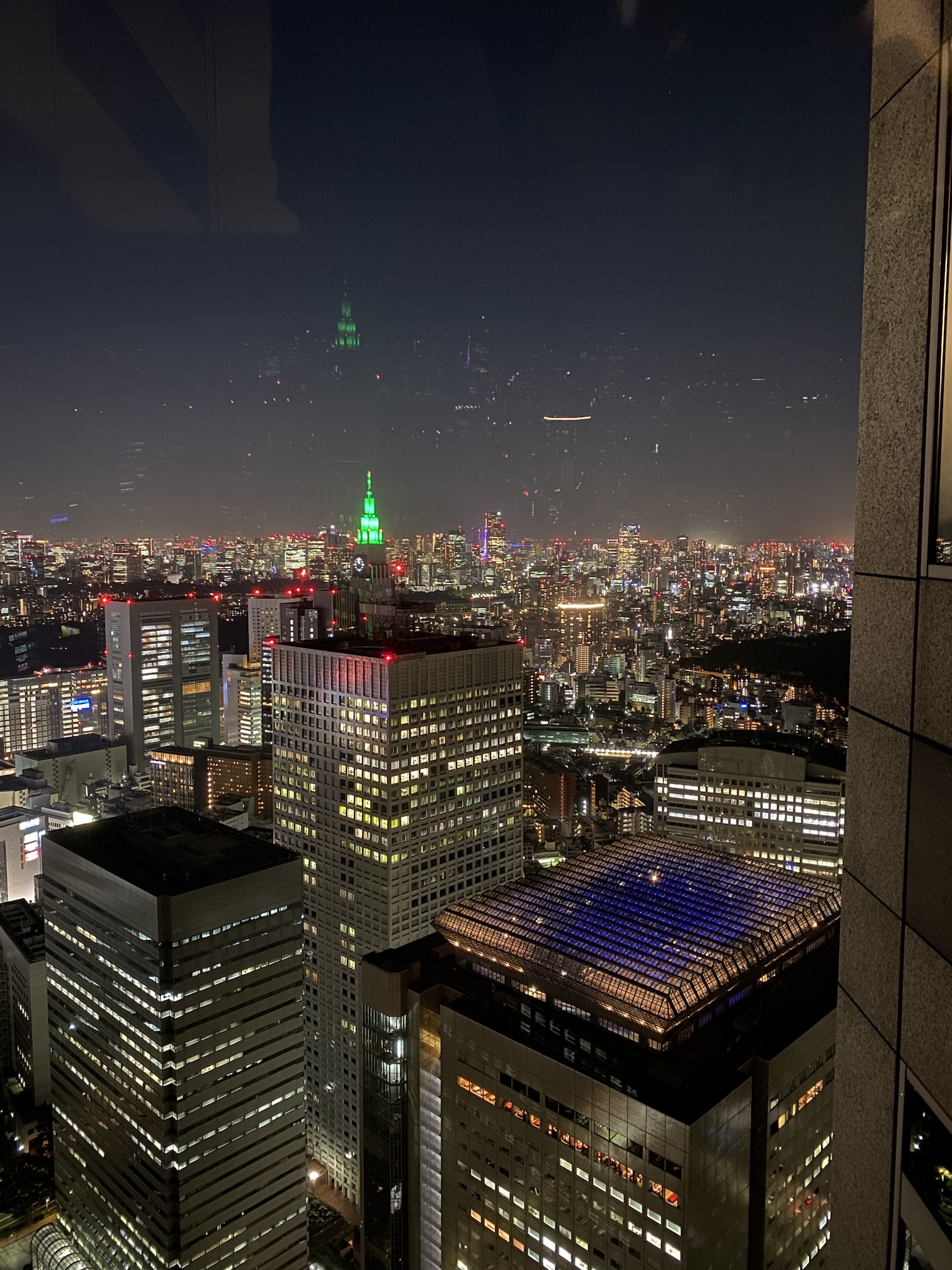
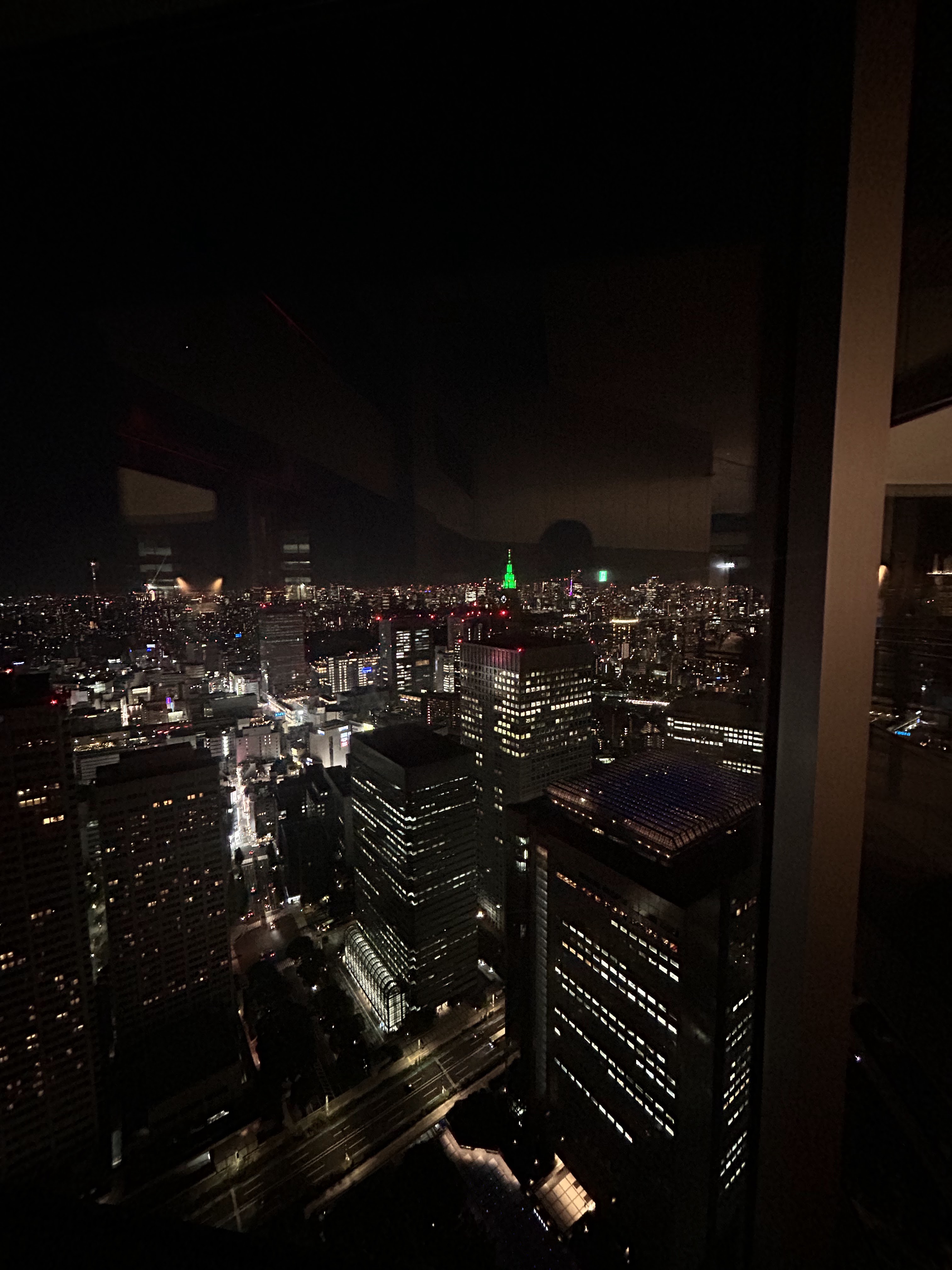
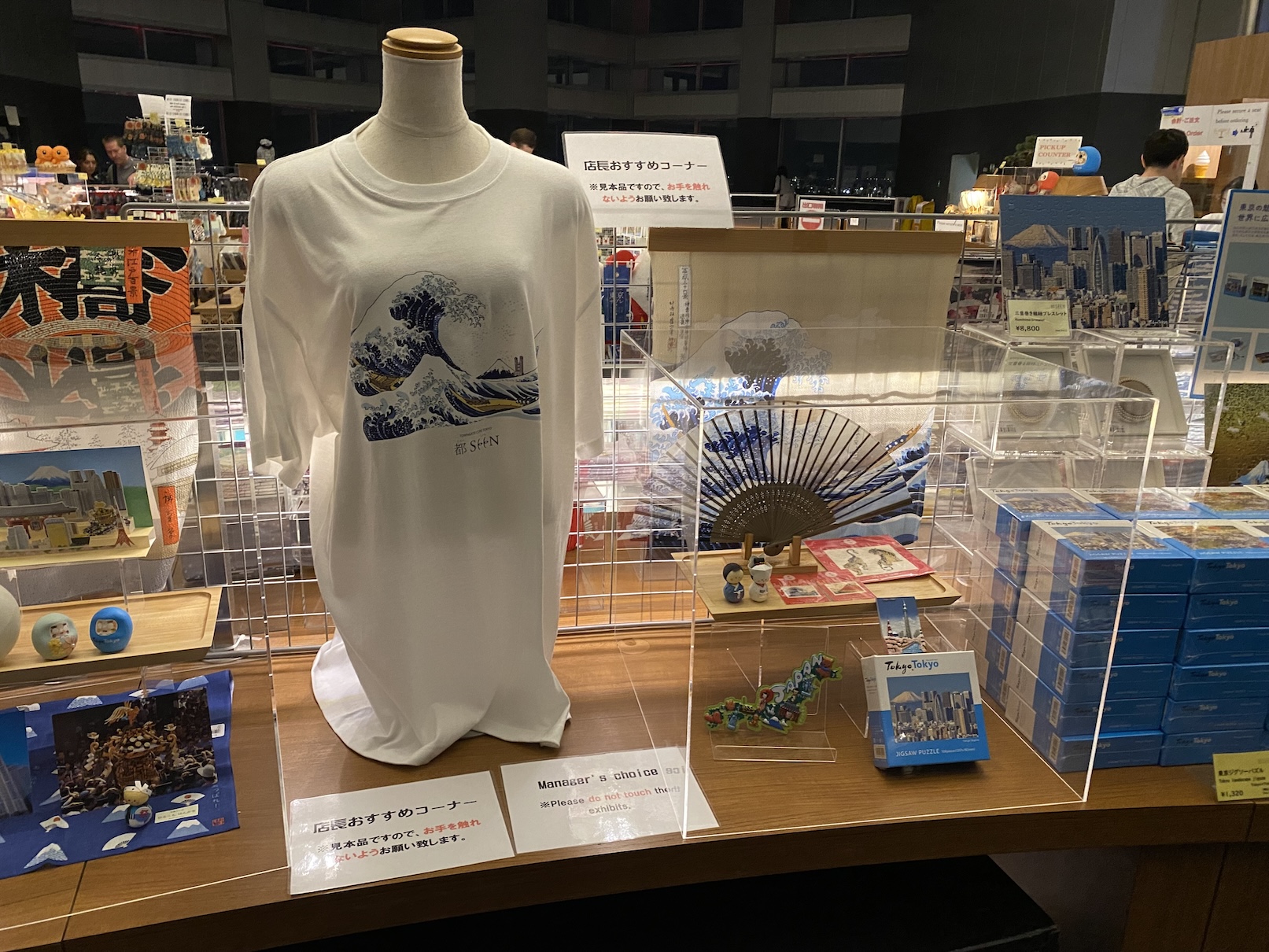
After staring out of the large windows, taking umpteen pictures, and bumping into other uni contingents, we eventually left because it closes by 10. A very kind lady gestured us into the lift while leaving, and graciously bowed. We bowed back. It was close to the end of her shift, and she must have done this a million times already, yet she still did it once again. People are respectful and truly dedicated to their jobs here.
Once down, we decided to walk down to Shinjuku, which was about a kilometre away. I had some internet, and decided to set the navigator to a place called Golden Gai, because the pictures on google photos looked good. But more on this later.
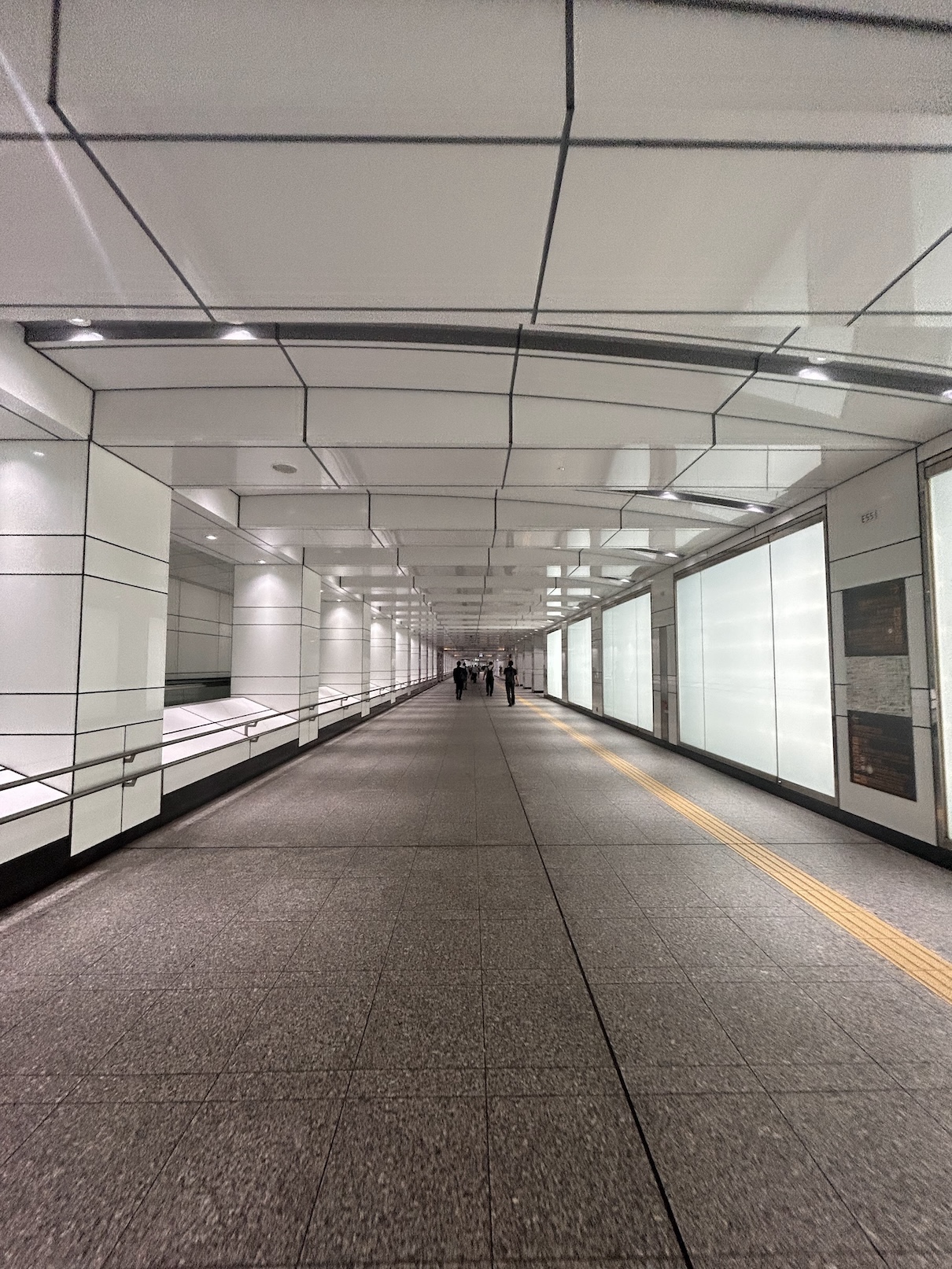
Google maps is great for pedestrian navigation in Japan. So great that it led us into this amazing food alley in Shinjuku
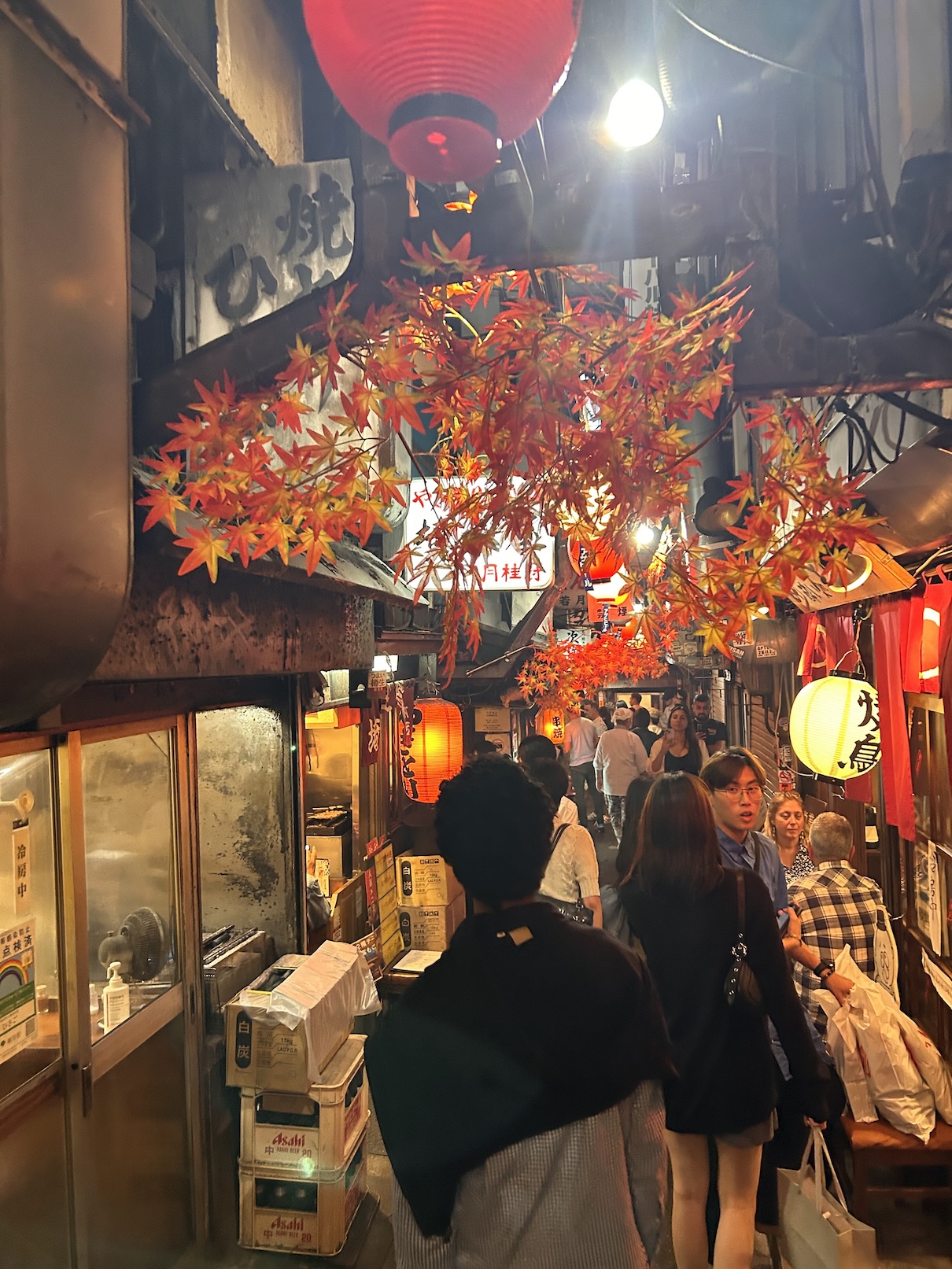
This place was super intsagrammable! Dense and smelling heavenly as a consequence of all the barbeques around. Coming out of the alley got us into Shinjuku proper
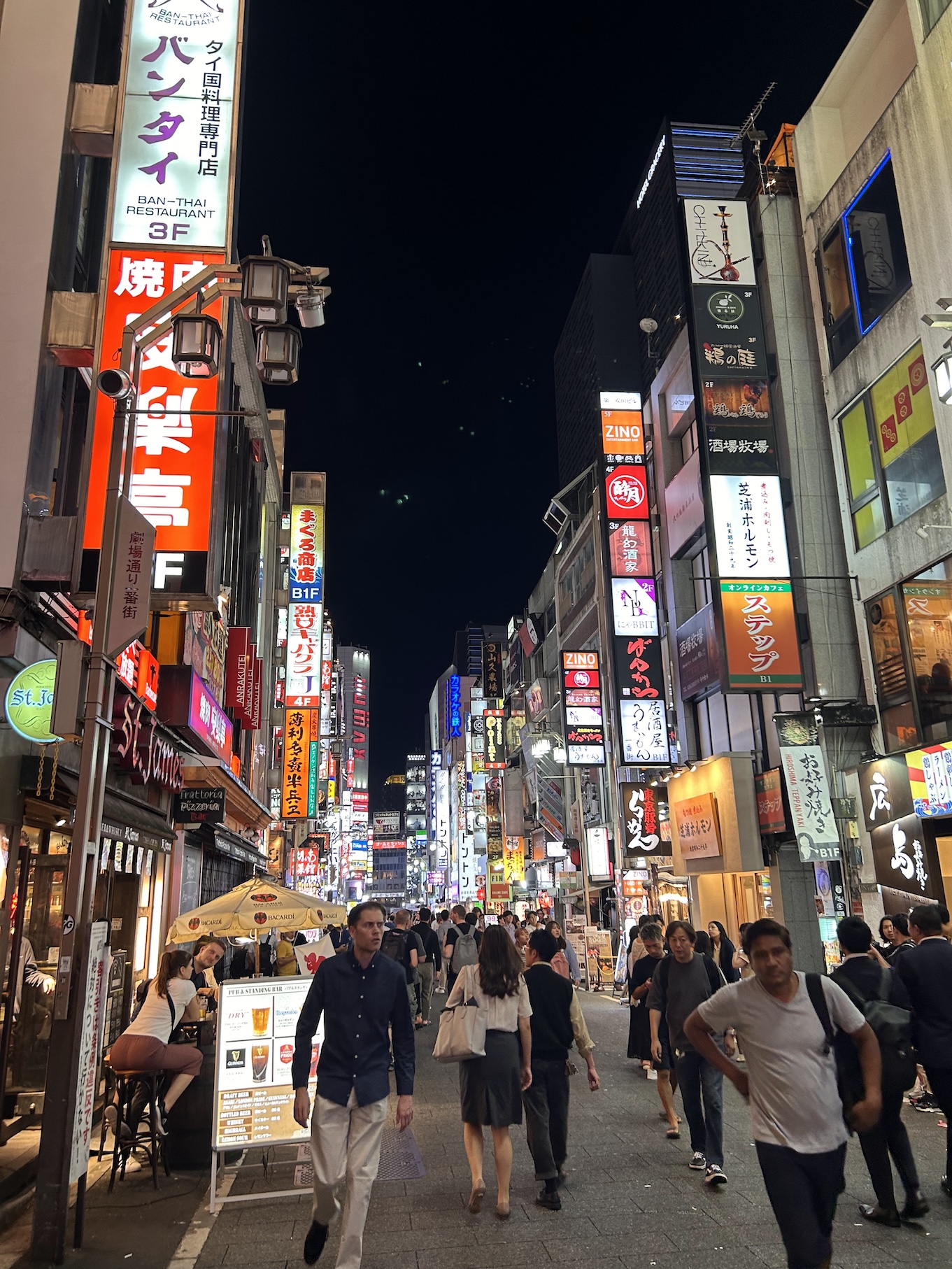

Shinjuku was just as, if not more eye-popping than Shibuya. The first thing we did was drop into a pachinko parlor, because why not?

The parlor was surprisingly devoid of youngsters. It was mostly middle-aged people watching their balls roll down the hole. Seemed both sad and amusing at the same time. We were willing to play for 100-200 yen, but the minimum wager was a 1000, so hard luck.
And now we come to Golden Gai. It was only once I returned back to my hotel that I learnt Golden Gai was a prostitution hotbed till 1958, when prostitution was criminalized3. Golden Gai today is a dimly lit set of six lanes with a lot of bars.
Since none of us drink, we took a walk up and down a couple lanes, and yeeted out of there quickly. Surprisingly, However, Golden Gai is not a cheap place to drink, and the clientele that it attracts are generally well off according to Wikipedia. Did I tell you photography is prohibited, and there’s a fee you have to pay to take photos?
Once we were out of Golden Gai, Raj and Rajeev wanted to go to a Casino. We hopped into a lift which took us to a poker casino + bar, but buy in was 10k yen and none of us were that good at Poker.
The next idea was to eat something. We finally dropped in to a small shop for Yakitori, and trust me, you need to know conversational japanese to live here comfortably. After a bit of menu finger-pointing because the waiter didn’t get english, a southeast asian cook came out of the kitchen and took our order. The yakitori was good, but a bit plain for my Indian palette, and quite expensive for the quantity in my opinion.
The metro journey back was a long one, and I immediately crashed, because we had a wake up time of 7 AM tomorrow.
Day 3,4,5,6
Stay tuned for Part 2 :)
Acknowledgements
The last time I wrote a travelogue, I promised to not write another long travelogue. And I wasn’t going to, until Atul said he was going to write one on his new blog, and I decided to play along.
Meanwhile, I also started reading a bit about writing (William Zinsser, Strunk and White), and thought I’d do this one properly. Unfortunately, this took a long time to write (I started in October) and an even longer time to edit and polish. There was an interview where George RR Martin asked Stephen King how he wrote so many books. King’s answer was very pragmatic:
I commit to six pages daily
That’s really hard to do! I realized this article wouldn’t end when it’s took me an hour to write the forty or so lines about the imperial palace. Writing well is very tricky business, and writing a travelogue in such detail is even more so. My free time is limited, and it doesn’t make sense to use it writing something neither I nor others will spend more than ten minutes on in the future. So part 2 is, diplomatically speaking, indefinetly postponed.
Of course, this trip wouldn’t have been possible if not for the generous support of JICA, JST and the Sakura Science Club. Thank you so much for hosting us. Also shoutout to Raj, Shriya, Rajeev and Atul for a lot of the pictures. And for putting up with me on the trip :P